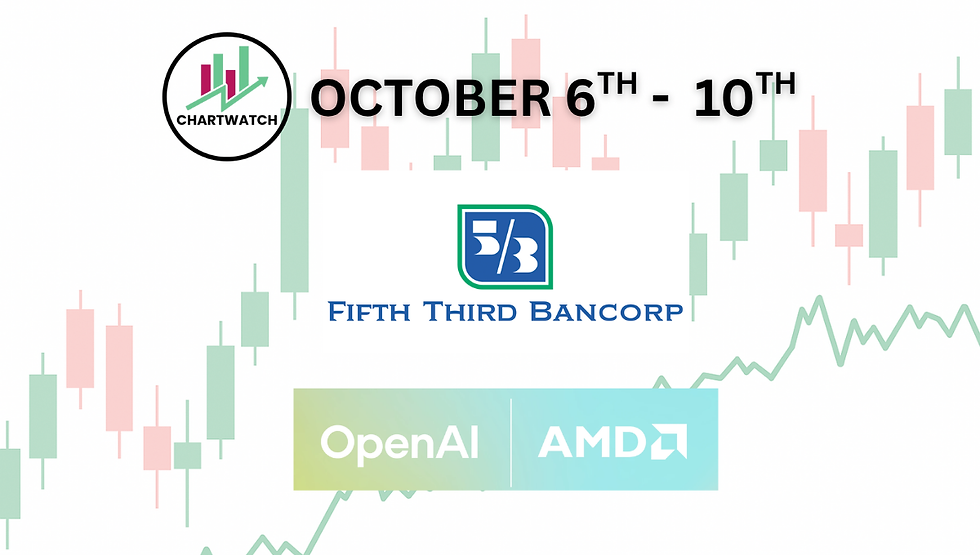Big Tech Booms, the Fed Splits, and Wall Street Weighs the Cost of AI
- Daniel Ledenev
- 12 minutes ago
- 6 min read
🎃 Welcome Back Investors! (October 27 to 31, 2025)
Halloween week brought no shortage of market drama brining a few sweet surprises. Big Tech took center stage as Microsoft and Apple posted strong earnings that pushed markets higher, while Meta scared off investors with massive AI spending plans. OpenAI grabbed headlines again, shaking up the tech landscape with new product announcements, deeper partnerships across Silicon Valley, and a vision to go public mid 2026 - 2027. Meanwhile, investors kept a close watch on the Federal Reserve, with growing expectations that cooler inflation could pave the way for another rate cut before year-end. As October wrapped up, Wall Street’s mood was upbeat, but a little haunted by just how fast the AI race is moving.
🤖 OpenAI’s Next Act: IPO Buzz and a $1 Trillion Valuation
OpenAI turned heads this week after reports revealed that the company is laying the groundwork for one of the most anticipated IPOs in tech history, one that could value the AI company at over $1 trillion. The move comes after an explosive global demand for generative AI tools and cloud partnerships, with Microsoft’s deep integration into OpenAI’s ecosystem fueling both firms’ momentum.
According to insiders, OpenAI has begun quietly preparing financial disclosures and exploring potential listing venues, though no timeline has been finalized. The company’s revenue has reportedly surged past $20 billion annually, driven by enterprise demand for ChatGPT Enterprise and API licensing deals with Fortune 500 companies. Analysts say a successful public debut could cement OpenAI’s position as the fastest growing private tech company since Nvidia’s breakout years. Still, some on Wall Street warn that the trillion dollar talk might be getting ahead of itself. Regulatory scrutiny, rising AI infrastructure costs, and growing competition from Anthropic and Google DeepMind could complicate the path ahead. But for now, OpenAI’s name alone is enough to keep investors, and rivals to watch closely.
🏦 Fed Faces Pushback After Halloween Rate Cut
The Federal Reserve’s quarter point rate cut this week didn’t land well with everyone inside the central bank. On Friday, two regional Fed presidents; Lorie Logan of Dallas and Jeffrey Schmid of Kansas City, publicly criticized the decision, saying inflation remains too high and the labor market doesn’t need more support.
Logan, speaking at a Dallas banking conference, said she saw “no need to cut rates this week” and warned she’d find it “difficult to cut again in December” without clear signs that inflation is falling faster or that the job market is weakening. Schmid, who actually voted against the cut, echoed the concern, arguing that the economy still shows solid momentum through consumer spending and business investment, and that easing policy now could risk fueling inflation further. Their unusually direct comments highlight a rare split inside the Fed just as Chair Jerome Powell tries to balance growth fears with price stability. Powell called the December rate decision “far from a foregone conclusion,” and markets have started to take him at his word. Futures traders now see lower odds of another cut this year, suggesting the Fed’s treat for markets might be its last for a while.
Earnings Roundup: Apple, Microsoft, and Meta
🌐 Meta
Meta’s quarter brought a mix of strength and concern for investors. Revenue jumped sharply on strong ad demand and steady engagement across its family of apps, but profits took a heavy hit from a one time U.S. tax adjustment that masked otherwise solid results. Growth in Reels, messaging ads, and AI driven targeting kept momentum high, while Reality Labs remained a drag amid rising infrastructure costs. Management struck an upbeat tone on the company’s long-term AI ambitions, pointing to Meta Superintelligence Labs and its push into AR glasses, but warned that 2026 spending will climb sharply as data center and compute investments ramp up. Shares slipped after the report as investors weighed robust core growth against an increasingly expensive AI future. In total, Meta reported $51.2 billion in revenue and $2.7 billion in net income, with the latter down sharply due to the $15.9 billion tax charge.
🍎 Apple
Apple closed its fiscal year on a high note, powered by strong iPhone demand and record breaking services revenue. The company credited its latest product lineup, including the iPhone 17 series, new AirPods Pro 3, and the M5 powered MacBook Pro and iPad Pro, for driving momentum into the holiday season. Customer loyalty and device satisfaction hit all time highs, underscoring Apple’s ability to grow even in a tougher macro environment. Executives highlighted continued expansion in the company’s installed base and hinted at confidence heading into 2026 as AI and on device intelligence deepen across its ecosystem. In total, Apple reported quarterly revenue of $102.5 billion, up 8% year-over-year, and adjusted earnings per share of $1.85, up 13%.
🖥️ Microsoft
Microsoft delivered another impressive quarter, with cloud growth and AI integration continuing to drive the company’s performance. Azure revenue surged as enterprise demand for AI infrastructure and data services remained strong, and its productivity segment, home to Office, LinkedIn, and Teams also beat expectations. Despite the solid results, investors reacted cautiously after CFO Amy Hood signaled that capital spending will accelerate again this fiscal year, as Microsoft races to expand capacity for AI workloads. The company’s close partnership with OpenAI remains central to its growth story, though rising infrastructure costs are starting to test investor patience. In total, Microsoft reported revenue of $77.7 billion and net income of $27.7 billion, with earnings per share of $3.72, beating estimates but sending shares down about 4% after hours on higher spending forecasts.
📦 Amazon
Amazon surged back into the spotlight with a quarter that impressed across nearly every segment. Cloud revenue at AWS jumped as enterprise demand for AI infrastructure accelerated, and digital advertising continued its rapid expansion. The company lifted its full year spending outlook, underscoring just how aggressive it plans to be in building out AI capacity, even as rivals like Microsoft and Google push deeper into the same space. Despite recent layoffs aimed at streamlining operations, Amazon’s scale and diversification kept growth steady across e-commerce, ads, and cloud. In total, Amazon reported revenue of $180.2 billion, up 13% year-over-year, and earnings per share of $1.95, beating expectations and sending shares up more than 10% on the day
👀 Stocks to Watch: What This Week’s Moves Reveal
Markets swung between optimism and caution as Big Tech’s spending spree collided with mixed signals from the Federal Reserve. Rising AI infrastructure costs, new IPO chatter from OpenAI, and pushback against further rate cuts kept investors rotating between growth and value plays. Here are the tickers that stood out:
Nvidia Corp. (NVDA | 8.7%) — Rose as Microsoft, Meta, and Amazon all raised capex forecasts tied to AI data center expansion. Investors see continued tailwinds for chipmakers powering the next phase of cloud and AI infrastructure growth.
Broadcom Inc. (AVGO | 4.4%) — Benefited from stronger demand expectations for custom AI accelerators and networking chips as hyperscalers race to expand data capacity. Analysts highlighted Broadcom’s growing role in enterprise AI hardware.
Adobe Inc. (ADBE | 3.7%) — Slipped as investors rotated away from software names seen as slower to monetize generative AI directly. Rising infrastructure spending from peers renewed questions about whether Adobe will accelerate its own AI rollout in 2026.
Delta Air Lines (DAL | 5.9%) — Fell on concerns that a pause in further Fed rate cuts could keep the U.S. dollar strong, pressuring international travel demand and raising jet fuel costs heading into winter.
Prologis Inc. (PLD | 1.9%) — Fell but could see recovery as e-commerce strength from Amazon and global trade optimism boosted demand expectations for logistics and warehouse space.
🛎️That’s a Wrap!
The final week of October kept markets buzzing as Big Tech earnings, OpenAI’s trillion dollar ambitions, and a divided Federal Reserve fueled sharp swings across sectors. Microsoft, Apple, and Amazon all topped expectations, though warnings of heavier AI driven spending tempered the excitement. Meta’s results showed solid ad growth but drew concern over soaring infrastructure costs, while Fed officials signaled hesitation about further rate cuts. With tech stocks powering fresh market highs and investors weighing the cost of the AI boom, Wall Street closed the month steady, confident in the rally, but mindful of how expensive innovation is becoming.
Until then, stay focused and stay curious. Catch you next week 👋
Sources
CNBC – Amazon’s stock soars 10% on third-quarter beat, increased spending guidance
CNBC – Microsoft stock drops on forecast for increased spending growth this year
Reuters – Exclusive: OpenAI lays groundwork for juggernaut IPO at up to $1 trillion valuation
The Globe and Mail – Two regional Fed Reserve bank presidents come out against this week’s rate cut




Comments